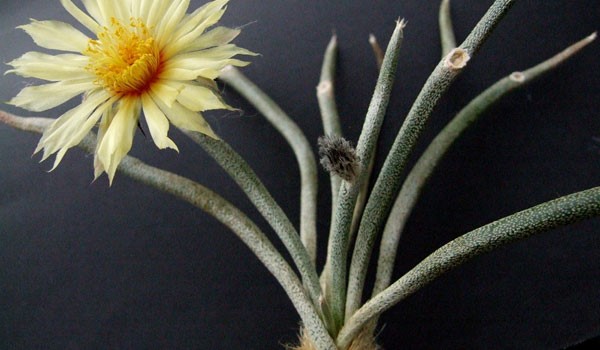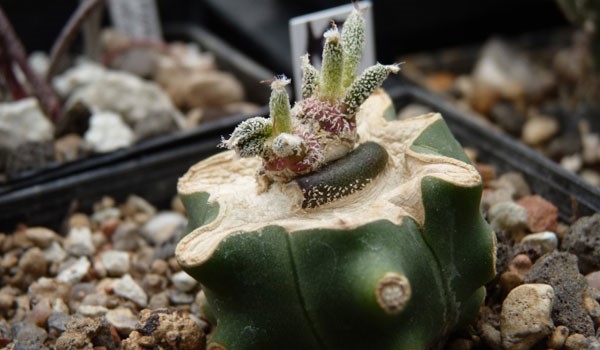Astrophytum Caput-Medusae Grafting & Care Guide

Like many other cacti, Astrophytum caput-medusae is also from Mexico (Nuevo León to be more precise). With its exotic appearance, this rare plant might not catch everyone’s eyes at the first sight, but its beautiful golden flowers certainly will.
In its natural habitat, you can find Astrophytum caput-medusae 100 to 200 meters above sea level among shrubs in clusters. Unfortunately, since it has a very limited distribution, this cactus is considered critically endangered. The main reasons that have made this plant an endangered species, are illegal over collecting and trampling by livestock.
Below, we’re going to cover some quick facts about this succulent, and then tell you everything you need to know about Astrophytum caput-medusae grafting and care.
Astrophytum Caput-Medusae Facts
- The name caput-medusae is a combination of the Latin words “caput” (head) and “Medusa” (a woman from Greek mythology whose hair turned into a snake).
- This cactus has thin, cylindrical, and smooth tubercles covered by stigmas. These dark-green tubercles grow up to 19 cm in length and 0.2 to 0.5 cm wide.
- With no stem ribs or central spines, caput-medusae has spiral areoles in the stem that grow 1.8 to 4.6 cm. It also has scattered hairy scales from 0.1 to 0.8 cm with a red-brown color.
- The beautiful 5-cm flowers of this plant bloom in the spring, and range from white to light green with a yellow base.
- The fruits are green, fleshy, and covered with scales when young. When ripe, they become dry and dark. These 5-cm cylindrical fruits hold the big seeds of this plant. The seeds are almost 3 mm long and have a dark brown to black color.
- As one of its varieties, Astrophytum caput-medusae f. nudum has dark glossy-green tubercles with a garden origin.
Propagating Astrophytum Caput-Medusae Seeds
Due to the slow growth rate of this succulent, propagating using the seeds is actually not recommended. But if you have patience and can provide all the requirements, you can try this method.
All you need to do is planting the Astrophytum caput-medusae seeds in a well-graining soil mixture. Also, don’t forget to cover the container with plastic to provide the necessary humidity.
Keep the pot in a light shadowy place, and provide the necessary temperature for it with heat math. When you see the small plant coming through the soil, remove the plastic.
If you’re planning to grow them outdoors, now it’s the time to accustom them to the sun. In order to do that, put them outside for a few minutes every day. Increase this time progressively each day. Remove the weak plants to prevent the spread of pests and diseases in the future.
Remember that you can propagate the seeds both indoors and outdoors. However, if you live in a cool area, make sure to propagate indoors.

Astrophytum Caput-Medusae Grafting
In their own roots or grafted, this plant grows considerably faster compared to the last method. For grafting, you’ll need:
- A sharp knife and a thin blade
- 70% alcohol
- Paper towel
- Rubber bands
- A caput-medusae and another cactus of your choosing (Rootstock would be nice)
When you have all the items ready, disinfect the cutting tools using the ethyl alcohol, and follow these steps:
- Choose a thick tubercle from the main plant, and cut about 5 cm of it using the blade. Make sure that it is the thickest so that it won’t dry easily after Astrophytum caput-medusae grafting.
- Cut the top of the Rootstock with the knife.
- Now take the tubercle and slice it evenly.
- Place the thick part of the sliced tubercle at the center of the rootstock’s vascular rings.
- Next, secure the grafts with rubber bands completely.
Place the pot in a bright-shaded location. You can also cover the grafted area with plastic for 3 days to prevent it from drying. You’ll see the result after a month or two. However, some grafts show signs of growth after 3 to 6 months. So be patients when after doing an Astrophytum caput-medusae grafting.

Astrophytum Caput-Medusae Care
This plant turns into something extraordinary when you take care of it correctly. Here is everything you need to know about the Astrophytum caput-medusae care:
Water
Correct watering is probably the most important thing to keep your Astrophytum happy. While avoiding over-watering, use the soak and dry method. This cactus should not sit on the water. So remove any excess amount of water after each irrigation to prevent root rot.
Soil & Fertilizer
As mentioned, a well-draining soil mix is suitable for this succulent. You can also prepare the soil yourself by combing cactus mix with perlite, sand, pumice, granite stone, or vermiculite for drainage. If your plant has a developed root system, using high potassium fertilizer for growth is recommended.
Tip: it is recommended to sterilize the soil before planting Astrophytum caput-medusae.
Light & Temperature
This plant prefers warm climates and thrives best in full to partial sunlight. If planting in the garden (which is an excellent choice), make sure it gets sunlight. While this plant enjoys the warm sun (25° C), it’s quite resistant to frost, and can survive temperatures as low as -1° C.
Remember that Astrophytum caput-medusae stops its growth at the end of August, and becomes winter dormant. In the month of March, it will start growing again.
Conclusion
Although an unusual cactus, this plant can create an eye-catching view with other succulents or even alone. With some love and patience, you’ll have a vibrant companion in your home for years!
- In this post:
- Astrophytum Caput-Medusae Facts
- Propagating Astrophytum Caput-Medusae Seeds
- Astrophytum Caput-Medusae Grafting
- Astrophytum Caput-Medusae Care



